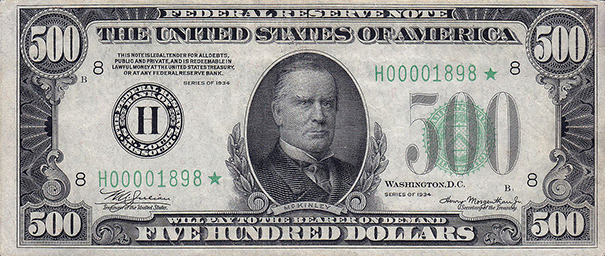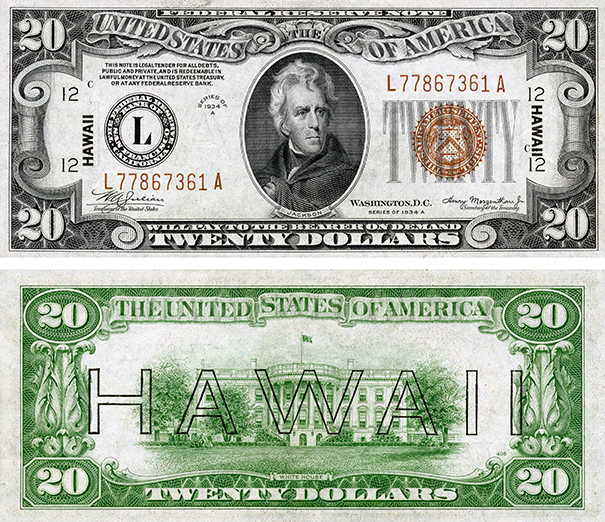…If you’re at all interested in money, you probably know that there are a bunch of U. S. notes and coins that nobody uses anymore. The whys and wherefores of this “forgotten” money makes for an interesting history.
 The original article has been edited for length (…) and clarity ([ ]) by munKNEE.com to provide a fast & easy read. For all the latest – and best – financial articles sign up (in the top right corner) for your free bi-weekly Market Intelligence Report newsletter (see sample here) or visit our Facebook page.
The original article has been edited for length (…) and clarity ([ ]) by munKNEE.com to provide a fast & easy read. For all the latest – and best – financial articles sign up (in the top right corner) for your free bi-weekly Market Intelligence Report newsletter (see sample here) or visit our Facebook page.
Notes and coins you can use, but nobody does
There is one coin and one note that I would use all the time, if they didn’t turn out to be so awkward to use at the checkout counter.
That would be the $1 coin, or Sacagawea Golden Dollar:

[Photo: United States Mint]
…and the $2 bill:

[Photo: United States Bureau of Engraving and Printing]
…If you’re going to transact business with a person, though, trying to hand over a dollar coin is going to slow things down and, probably even worse, would be trying to use a $2 bill. They’re ordinary circulating bank notes — legal tender, currently issued Federal Reserve notes. You can buy as many as you want at your local bank (although it might take a short wait while the teller visits the vault) but, once again, if you use them in a checkout line, you’re likely going to catch the cashier off guard. They’re that rare.
Notes and coins you could use, but shouldn’t
There are also some notes and coins that are rare enough to be valuable. Using them as legal tender would be a waste of money.
Large-denomination notes
There used to be $500 and $1,000 bills circulating as regular currency. They were useful for large transactions (buying a business, buying real estate, etc.) in times and places where it might take days to clear a check (or even know if it was good).

By the 1960s, those times and places had gotten pretty scarce, and there was a general sense that the main reason someone might use these sorts of high-denomination bank notes was to engage in illicit transactions — drug deals, bribes, political payoffs, and so on.
In 1969, President Nixon ordered the $500 and $1,000 bills withdrawn from circulation in order to make corrupt payments harder.
However, it remains a point of pride for the U.S. Treasury that legal tender U.S. currency remain legal tender: The public can rely on money that has ever entered circulation at its face value so you can still use a $500 or $1,000 bill if you have one…but it would be a dumb idea, because they’re worth more than face value as a collectible. The particular price you’d get depends on the rarity and condition of the bill, but certain rare $500 bills reportedly sell to collectors for as high as $10,000.
There used to be $5,000 and $10,000 notes, as well. There was even a $100,000 gold certificate, but it never circulated: It was issued by the U.S. Treasury to Federal Reserve Banks against gold deposited with the Treasury, and used to balance the books among the different Federal Reserve Banks.
U.S. Mint bullion coins
The U.S. Mint issues a whole series of silver, gold, and platinum coins which are legal tender.
The American Eagle one-ounce gold coin is legal tender for $50, but since the coin would cost you $1,500 or so, you wouldn’t want to spend it. The gold coins come in a bunch of fractional-ounce sizes as well. There’s also a one-ounce silver coin: legal tender for $1, street value about $20.

[Photo: United States Mint]
These are legal tender for a specific reason that has nothing to do with the idea that anyone might actually spend them: The purchase and sale of legal tender instruments isn’t subject to sales tax. (Which is a good thing. Imagine having to pay sales tax if you changed a $20 into $5 or $1 bills at the bank!) Because of the technicality that the U.S. Mint’s bullion coins have a face value, you can buy and sell them without paying the sales tax.
Notes and coins that were short-lived
There have been a few oddball notes and coins that were very short-lived. Today, these are worth far more than face value when sold as collector’s items.
Hawaii overprint dollar
During World War II, there was considerable concern that Japan might invade Hawaii, and part of the concern was that doing so would give them access to the currency on the island in the hands of banks, business, and ordinary people. With those dollars, Japan would be able to buy weapons, fuel, and other war material.
The U.S. responded by withdrawing all the currency from circulation, and replacing it with currency that had the word Hawaii overprinted on both sides.

[Photo: National Numismatic Collection, National Museum of American History]
The idea was that, if there was an invasion, the U.S. could demonetize the overprinted dollars, making them worthless to the invaders, but that on the islands they could circulate normally until or unless there was an invasion.
After the war the overprint currency was replaced with ordinary notes.
Trade dollars
In the 1870s, trade between China and the West largely depended on Spanish silver dollars. This annoyed traders from many other countries, who disliked having to buy the foreign coins to pay the Chinese.

Because this happened just as a gold standard (rather than a bimetallic system based on both gold and silver) was emerging, the legal-tender status of these silver coins was in flux. Initially they were legal tender only up to $5. When the price of silver fell, making their face value more than the silver content, and the coins started flowing back into the country, Congress responded by officially demonetizing the trade dollar in 1876.
Related Articles From the munKNEE Vault:
1. An Inside Look At the U.S. Dollar Printing Process
Have you ever wondered how dollar bills are made, why currency is too hard to replicate? Check out the infographic below to learn about the process that goes into printing U.S. paper currency.
2. Check Your Change! Certain Recent US Coins Are Worth $Thousands
There are a number of U.S. error coins and die varieties in circulation today worth from $30 to $35,000 because they have small distinguishing characteristics that make them rare and valuable. This article will tell you which of your pocket change coins might be worth a large premium over face value, and why.
3. A Close Look At the U.S. Dollar
The U.S. $1 dollar bill has been redesigned many time since first being issued back in 1862. What we almost exclusively use today is the version designed in 1963. The following extremely informative infographic explains what all the different symbols on the dollar mean, who is on the front & back of all the U.S. currencies currently in use and the $500, $1,000, $10,000 and $100,000 (yes, $100,000!) bills that are no longer in production.
4. Love Money? Then You’ll Find These U.S. Currency Facts VERY Interesting
Has U.S. currency as we know it today always been pretty much the same? The answer is no. If you love money as much as I do, you’ll love the infographic below and all the money facts it contains. Take a look. It’s very interesting!
5. Dirty Money: Here’s What’s Lurking In Your Wallet & It’s Absolutely Disgusting!
Let’s break it down, and discover the filthy truth of what is probably lurking on the money in your wallet. Be forewarned, it is downright disgusting!
 munKNEE.com Your Key to Making Money
munKNEE.com Your Key to Making Money